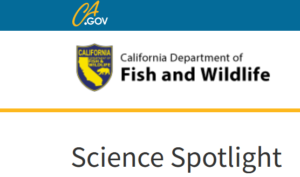The California Department of Fish and Wildlife updated their science page yesterday with a brand new discovery. Brace yourselves. This is going to blow your socks right out the door. I don’t mean to be so shocking so early in the day or so early in the year.
But apparently beavers are good for things.
CDFW beaver management policies get a refresh
Thanks to funding approved in the state budget, the California Department of Fish and Wildlife (CDFW) is now in the process of building upon its existing beaver management policies and laying the groundwork for projects that harness beavers’ natural ability to improve California’s ecosystems.
The state budget approved $1.67 million in fiscal year 2022-23 and $1.44 million in fiscal year 2023-24 and ongoing for CDFW’s beaver restoration program.
 CDFW is currently hiring five dedicated scientists to work on a comprehensive approach to beaver management. Once hired, staff will work on numerous projects and collaborations including developing a toolkit to help prevent property damage due to beaver activity and to foster co-existence with the keystone species. Staff will also collaborate with partners on ongoing and future restoration projects to relocate beavers into watersheds where their dams can help restore hydrologic connectivity and promote resiliency to climate change and wildfire.
CDFW is currently hiring five dedicated scientists to work on a comprehensive approach to beaver management. Once hired, staff will work on numerous projects and collaborations including developing a toolkit to help prevent property damage due to beaver activity and to foster co-existence with the keystone species. Staff will also collaborate with partners on ongoing and future restoration projects to relocate beavers into watersheds where their dams can help restore hydrologic connectivity and promote resiliency to climate change and wildfire.
Ooh a tool kit! What do you think it will have in it? The fact that it has taken them 6 months to hire these 5 scientists doesn’t fill me with hope. I guess they were all in shock the first three. You mean these rodents you told us were’t native are USEFUL?
“We’re incredibly excited about the direction the department is going with its beaver restoration program,” said CDFW Deputy Director Chad Dibble.
Anyone paying attention to wildlife in the media recently may be seeing that beavers are having a moment. A recent article in Mother Jones posed the question: “Is it possible that beavers got a publicist?” The article concludes that beavers are finally getting the “rebrand” they deserve. While beavers have always been known for building dams and altering waterways, perhaps less publicly known is the positive impact they have on larger ecosystems surrounding their dams.
“Beaver dams raise groundwater levels and slow down water flow which allows water to seep into the soil and helps create riparian wetlands that support plant, wildlife and habitat growth,” said CDFW Director Chuck Bonham in an Op-ed written for CDFW and published in Outdoor California magazine.
By aiding healthy riparian growth, beaver dams can mitigate drought impacts and support climate change resiliency. The process of increasing fuel moisture and helping larger areas of land retain water can potentially stop or slow the spread of wildfire moving through an area. Beaver dams also improve water quality and help rejuvenate habitat for salmon and aquatic insects.
I’m sure this came as quite a surprise to the average man on the street, but was it really a surprise for YOU??? I mean this is what you do for a living. It is your Raison d’être so to speak. Someone how I expected you to know better.
I remember attending and art commission meeting and one of the commissioners commented that before he had known what a high quality mural was in his office he had asked that it be painted over. He bemoaned that he would NEVER have done such a thing if anyone had simply told him it was valuable before.
It’s not like the man had eyes and could see the art for himself. And its not like fish and game ever had cause to notice that there were way more birds and frogs and otters at beaver ponds before someone instructed them to pay attention.
What do you expect from them anyway?
Over the past several years, CDFW has spent millions of dollars partnering with tribes, NGOs, landowners, and state and federal agencies implementing beaver restoration projects. With its new beaver restoration program, the department is embracing the paradigm shift surrounding beavers and continuing its work to bring together collective knowledge and implement a comprehensive approach to beaver management.
“We’re continuing collaboration with partners and stakeholders, continuing work on restoration sites where we’ve funded beaver dam analogues and continuing to lay the groundwork for re-introduction of beavers in areas where it may have ecosystem benefits. Scientists are confident that beaver restoration has the potential to be a nature-based strategy that can aid in reducing wildfire risk, mitigating drought and combating climate change. It’s another piece of the puzzle as CDFW works to implement solutions to some of our greatest environmental concerns,” said Bonham.
Okay, I’ll grant you the fire research is NEW. And the salmon research is 30 years old so practically new to you. But the DROUGHT effect had to have been obvious all along. And the biodiversity was visible to the cave men so what on God’s green earth has taken you so long???
I guess it’s like the parable of the prodigal son. They should have known better and come around sooner but that’s not the point. Just be glad they got here eventually.
‘”It was fitting to celebrate and be glad, for this your brother was dead, and is alive; he was lost, and is found.”






































